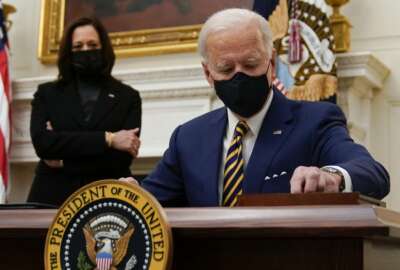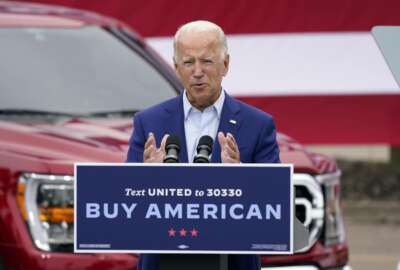

The Biden administration has proposed $9 billion for the technology modernization fund. With more, federal sales and marketing consultant Larry Allen.
Best listening experience is on Chrome, Firefox or Safari. Subscribe to Federal Drive’s daily audio interviews on Apple Podcasts or PodcastOne.
It’s enough to make the heart quicken. Imagine a sudden, 10% bump in federal spending on information technology. Yet that’s exactly what the Biden administration has proposed in its request for $9 billion in the technology modernization fund. Congress has been super-stingy with the fund until now. That could change with Democratic control, though. With how the money might schmear around, federal sales and marketing consultant Larry Allen spoke with Federal Drive with Tom Temin.
Interview transcript:
Tom Temin: $9 billion, that would be real money for the TMF, wouldn’t it Larry?
Larry Allen: Tom, that would be a substantial injection into the technology modernization fund, a fund that at best has been funded in increments of tens of millions of dollars, taking it up to 9 billion would really get people’s interest and attention.
Tom Temin: Yeah. And so the question is, how would contractors position themselves to get some of that?
Larry Allen: Well, Tom, I think the real genesis here is that contractors would once again be interested in technology modernization fund projects. When Congress originally created the fund, there was a lot of discussion in industry about how to work with federal agencies on projects. And in fact, there were several initiatives where contractors and their federal customers worked together. And indeed, those projects, the smaller ones that the fund was able to handle at that dollar level, went through. But a number of contracts are set, really, it’s only going to be maybe $10 million per project. That’s not really enough to interest me, I’m going to go back and do business the regular way. And as a result, some of the people that do a lot of federal IT business, some of the lead systems integrators, even the medium sized ones, basically said come back and tell me when there’s something real going on here. Well, now it looks like we have the prospect of something real going on once again. So that’s going to bring renewed interest among industry. It’s also, I think, going to broaden interest in the federal sector. Look, we’ve got a number of appointed Chief Information Officers, but we’re also going to have a lot of new politically appointed CIOs coming in, they’re going to be looking for ways to modernize outdated infrastructure, the TMF fund is now going to be a much more viable option for doing that. It’s not appropriated in any one area so agencies have the option of deciding which of their systems need the most work, writing a business case around it to support that, and then going forward to get approval for the fund.
Tom Temin: Yeah, so it’s just a matter of whether Congress will go along at this point. And now that you have democratic control, and probably for the republicans, my sense is that has not been a big enough deal such that if the democrats really want that level of money in a bill, they really want, that’s not the thing that the republicans would object on.
Larry Allen: Well, there’s a question mark here about what will happen on this proposal when it gets to the Senate Tom. The Senate has traditionally been the stumbling block for giving the TMF fund more money. Senators really want to see proof that existing projects have gone well, and it is a revolving fund. So the other thing they want to see is that agencies have actually found a way to pay back the money that they were supposed to pay back. The House is not a problem, the House is not going to be a problem this time. You’ve already had a letter signed I guess by half a dozen House members saying this is what we want. I think the only reason to get excited about this is that House and Senate leaders are looking at attaching the TMF bill to the next round of COVID relief, that’s certainly going to be a very popular bill. It’s going to be what legislation launchers call a Christmas tree that is is going to have lots of things attached to it because it’s going to be seen as a must pass bill. The TMF could be part of that. And if it is, I think there’s a very good shot we’ll see this go through.
Tom Temin: And I want to get your take on the Buy America initiative. This is something that Biden administration has promised to do and now it has an executive order on Buy American., How do you think that will really effect federal procurement since Buy America rules go back decades to begin with?
Larry Allen: I think the first effect we’re going to see from the President’s executive order is confusion, confusion at federal agencies about what are they supposed to do now. They’re supposed to give extra preference for American made goods. Well, okay, how much of an extra preference because depending on what you’re buying, there’s a whole lot of different ways Buy American Act is applied. Different levels of offsets before Buy American goods and goods that don’t meet that standard. But also confusing because the The executive order is going to change the standard of what constitutes a Buy American compatible piece of equipment. Right now, the test is a straight component test. The executive order contemplates at putting value add into the equation, which I think is great. It’s going to add some flexibility to what’s considered an American made product. But it’s something that’s going to have to be worked out in the regulatory process Tom to see exactly what that new definition becomes. So a little bit of confusion here. I think the other two other things that I’m watching with this Buy American Act pronouncement. One is that it creates a new, nobody likes to use the word SAR, but that’s really what it is, it’s going to be made in America rules SAR that sits over at the Office of Management and Budget that’s going to review all of the Buy American Act waivers, they’re going to be the place to to which agencies have to go ultimately. That’s been one of the real concerns about Buy American laws. You pointed out the top that Buy American laws have some sort of been in place for many years, decades in fact. They’re not always well followed, they’re not always well understood. One of the intents of this executive order is to make sure that they are more closely tracked, and that their waivers that are given are given on real need, not just because it’s an expeditious thing to do. Lastly, we’re gonna have to look to see how this executive order changes the relationship between the Buy American Act and the Trade Agreements Act.
Tom Temin: Right. That’s where it gets complicated.
Larry Allen: It can get very complicated. Right now, it’s the case that either Buy American applies or Trade Agreements applies, you don’t really have the situation where both acts apply at one time. And changing the level at which the Buy American Act applies to a US procurement could have some real repercussions for international trade agreements that the US has signed on to that include the Trade Agreements Act as part of them. So that’s definitely going to be a space to watch. So I think it’s going to take a while before the dust settles on this. I know that the executive order is well intended. I know there’s a lot of concern in the acquisition community about supply chain security and readiness, particularly in light of the issues we had in the early days of the pandemic. So I understand what the motivation is or where this is coming from. Like anything else, we’re going to have to make sure that the implementation of it doesn’t cause more problems than it was intended to solve.
Tom Temin: And we don’t know whether this will require rulemaking either because we don’t have anyone in the Office of Federal Procurement Policy yet, which you would think would have something to say about this.
Larry Allen: There’ll definitely be a host of rulemakings. I anticipate that there will be multiple FAR council pronouncements on this. The executive order directs the Office of Management and Budget to look at certain parts of the order in order to promulgate regulations. Acting administrator Leslie field, once again, came rushing to the floor year, but she’s very experienced in doing this. And another thing that I hadn’t mentioned that they’re gonna have to look at, at OFPP specifically, right now there’s a exemption from the Buy American Act for commercial off the shelf IT that’s been a big deal. It’s something that’s made commercial off the shelf IT very easy to work with in the government. This executive order directs OMB to take a look at that exemption to see if it’s still something that works. Is it still something that is in the best interest of the government? And that could also set off its own chain reaction of issues that people will have to examine in terms of what they buy if they’re on the federal side and how they sell if they’re on the industry side.
Tom Temin: That’s right. This could bring the revival of the zenith PC.
Larry Allen: It could, it could.
Tom Temin: Alright. We’ll hope so. Larry Allen is president of Allen Federal Business Partners. As always, thanks so much.
Larry Allen: Tom, thank you and I wish your listeners happy selling.
Copyright © 2025 Federal News Network. All rights reserved. This website is not intended for users located within the European Economic Area.
Tom Temin is host of the Federal Drive and has been providing insight on federal technology and management issues for more than 30 years.
Follow @tteminWFED



